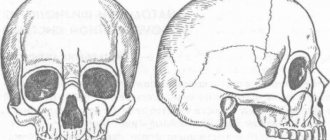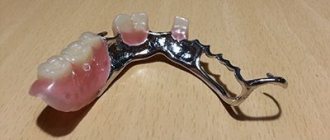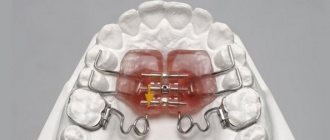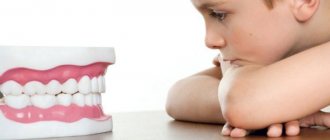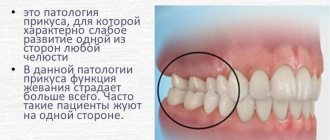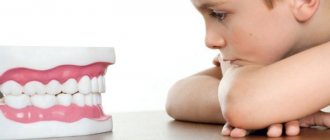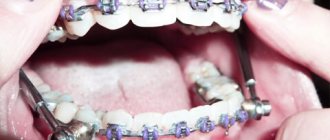4591
Bite correction during the period of changing primary teeth to permanent teeth occurs much easier and faster than moving row elements in adult patients.
For this reason, orthodontic treatment for children does not always require wearing visible and uncomfortable braces.
In most cases, the position of the teeth relative to the jaw line can be corrected using a removable structure - a plate equipped with a Bertoni screw.
General overview
The Bertoni screw is a fastening system that is an integral part of orthodontic leveling plates.
Made from plastic and metal alloy, which has excellent biocompatibility with natural tissues.
The thread and body of the element are made with maximum precision, and the surface of the rod is so smooth that the rotation of the thread and its sliding are very easy and do not cause additional inconvenience while wearing the device.
The design features of the screw completely eliminate its uncontrolled displacement. Main indications for use:
- change in the structure of the upper jaw row towards expansion. The best result can be achieved at the stage of formation of hard bone tissue, which occurs in childhood;
- for single or fragmentary movement of organs. The doctor sets the desired direction and distance within which the displacement must be achieved. These parameters determine the duration of the correction course.
Peculiarities
Plates with a Bertoni screw are selected individually, taking into account the anatomical features of the patient’s maxillofacial apparatus.
To obtain lasting positive dynamics, the device must be worn almost around the clock, removing it from the oral cavity only when necessary.
The fixation process occurs with the help of special hooks that are quite simply thrown over the teeth. This allows you to remove and put on the system yourself without the help of a specialist.
The principle of operation is to periodically tighten the screw mechanism, thus setting the required pressure force. As a rule, the doctor will do this the first time. Then, during the treatment process, the tension force of the metal arches is adjusted at home.
The Bertoni screw is the active part of the leveling structure. It has several independent guides, which makes it possible to adjust each sector independently. This allows you to stretch the teeth in the desired direction.
A special design advantage of the element is its three-dimensionality, which made it possible to combine two screws together - an expanding and an extending one. Thus, the plate itself has become significantly lighter and thinner.
What is the Brückle apparatus and the stages of its manufacture in the laboratory.
Let's talk here about the effectiveness of Ortho Snap aligners.
At this address https://www.vash-dentist.ru/ortodontiya/kapyi/nevidimyie-elayneryi-star-smile.html you will find reviews about Star Smile aligners.
Plates or braces for teeth?
This choice cannot stand - dental plates and braces have different functions. The former affect the entire dentition, the latter have a wide range of functions and solve various orthodontic problems: from the curvature of individual teeth to malocclusion and crowding. Also, the plate cannot be placed if the child has developed traumatic periodontitis, in which a fracture of the cortical plate of the tooth is possible. However, these two devices can be used in combination - first the child will be given a plate, and then braces.
Types of plates
There are three types of orthodontic leveling mechanisms, each of which has individual indications for use:
- standard plates - used for minor bite defects when serious correction of the anomaly is not required. An ideal solution for giving the correct direction of growth to individual dental elements;
- with the addition of active components - they effectively align fragmented lesions and more complex occlusion pathologies. Such structures have a screw mechanism that regulates the tension force of the plates, which actively influence the direction of tooth growth;
- designs with a Bertoni screw - got their name in honor of their developer.
They make the system as efficient as possible. The main indication for use is correction of children's bite. The plate is less convenient in comparison with analog versions, but the results are several times superior to them.
The video describes in detail the types and principles of operation of the plates.
Device characteristics
The product consists of a plastic base, in the center of which there is a screw made of a medical metal alloy. There are arcs along the edges.
Localized parallel to the area of the lateral dental fragments, the arches create the load necessary for the therapeutic effect.
The device is made of medium-hard plastic. The color can be any. In this case, the shape of the plate repeats the palatal relief.
The arc is made of nickel or titanium alloy, and has the ability to “remember” the direction given to it. The thickness of the wire may vary.
The device is attached to special hooks made of the same material as the arcs.
In a number of models, activators are built into the plate, with the help of which the system is controlled. This is very convenient because one device is used throughout the entire correction period.
How to tighten a dental plate?
The twisting procedure is necessary to increase the load, as well as expand the main surface of the plate, which is installed on the upper jaw. Your doctor will tell you how to tighten the dental plate and how often to do it. The process itself is not too complicated: using a key inserted into the main hole of the screw, one turn is made along the guide arrow on the tooth plate. After this, the child may feel discomfort for some time, but this procedure is necessary to achieve the desired result. In addition, if necessary, the plate can be returned to its previous position by turning back.
Dental plastic with a key for twisting
Preparing the child
Alignment of teeth using this method is indicated at the stage of mixed dentition in a child. At a later age, this procedure is ineffective. Baby teeth are more amenable to correction of anomalies when the pressure force is not too high.
Despite the fact that the correction itself is not a particularly complex manipulation, at all stages of treatment the child should be under the periodic supervision of a dentist.
This requirement is due to the fact that the placement of the organs has not yet been fully formed and incorrect use of the device can cause harm to the teeth, including their complete loss.
The first place to start is visiting an orthodontist. The doctor will examine the oral cavity, evaluate the clinical picture and the degree of neglect of the anomaly, and prescribe an x-ray.
This analysis is a mandatory requirement. It provides more complete information about the condition of the jaw row, since only the crown part of the tooth is on the surface, and everything else is hidden from the eye of a specialist.
Based on the collected medical history, the doctor selects the type of device and gives parents detailed information about the principle of treatment, correct operation and measures for caring for the device.
At the preparatory stage , a treatment plan is developed, the approximate duration of the course, nuances are discussed - when the structure can be removed, how often to do it, how to help the baby quickly adapt to the presence of a foreign object in the mouth and minimize physical discomfort from its use.
Let's sum it up
Before tightening a dental plate for a child, you need to learn how to do it correctly. Immediately after installing the structure, the orthodontist independently activates the device and shows how to regularly adjust it. For this purpose, a special screw mechanism is provided, and the patient’s parents are given a key, which is inserted into the hole and scrolled the required number of times. How many revolutions and how often they need to be done depends on the individual schedule developed by the doctor.
Sometimes during twisting certain difficulties arise. If you take timely measures and go to the clinic, the damaged device can be restored without consequences for the treatment process.
Video on how to properly tighten a plate to straighten teeth:
Correction process
The treatment process begins with making an impression of the jaws. It is made from a wax mass. It is from this copy that the laboratory will form a plaster version of the removable braces.
The template will become the basis for the production of the plate , guaranteeing its maximum compliance with the anatomical features of the structure of the child’s jaws. It completely repeats the relief of the crown part of the tooth and gums.
During a follow-up visit to the doctor, the finished design is tried on, and if there are any discrepancies, adjustments are made. It takes no more than 10 minutes. The doctor shows how to independently change the tension force of the arc .
The specialist also determines the period until which the plate will be used, and with the onset of the first visible improvements, it will be clear what time frame the correction will be limited to.
The system is designed in such a way that a number of its active fragments can cause physical discomfort to a small patient, especially during the period of adaptation.
Sharp fragments rub the mucous membrane and can scratch the tongue. If your baby complains of pain, you should visit a doctor and have the device adjusted.
Since the plate is quite voluminous, adaptation to it occurs gradually. As a rule, the discomfort goes away after 15-20 days. Speech and chewing functions are completely restored.
How comfortable the rehabilitation will be largely depends on the behavior of the parents. Their attention, care and patience will help the child cope with the difficulties of adaptation.
Correction of bite defects using the T4A trainer and the principle of operation of the device.
This material contains detailed information about T4K trainers.
Follow the link https://www.vash-dentist.ru/ortodontiya/prikus/chto-lechit-vrach.html if you are interested in who a pediatric orthodontist is.
Main period
When the plate is selected, the doctor secures it in the patient’s mouth. Installation is carried out taking into account all possible nuances of wearing the plate.
The child must indicate in which places she rubs hard or does not hold. The number of turns of the key to accurately secure the plate in the mouth is calculated so that parents know how much the load on the jaw can be increased. The doctor must take into account all the uncomfortable moments in the process of fixing the plate.
Sharp corners, if any, must be adjusted to make the child comfortable. The design should not rub.
If inflammatory lesions appear during wearing, this means that it is not fastened correctly. Parents should monitor this moment. It is important to ask the child how he feels and listen carefully to his words.
Features of wearing plates with a Bertoni screw:
- The maximum effect is achieved only if the structure is worn around the clock.
- If there are minor anomalies, then wearing it can only be done during sleep.
- If the structure rubs the palate, gums or tongue, it is important to immediately see a doctor to have the plate adjusted.
- The child’s adaptation to wearing the plate takes an average of 2-3 weeks.
At first, the child may complain of discomfort, since the plate takes up a lot of space in the mouth. Its base is capable of covering the entire plane of the sky.
It can also temporarily make swallowing difficult and affect speech. Such changes are temporary, so within 2 weeks the small patient should get used to such design features.
In order for the wearing to be correct, parents must control all processes. It is important to keep an eye on the following points:
- how the child installs the plate;
- whether the screw is tightened correctly;
- whether the plate is removed before eating;
- whether the hygiene of the mouth and the entire system is carried out correctly.
Visits to the orthodontist should be regular. For the first 2-3 weeks, it is important to visit the doctor as soon as the child feels that the plate is rubbing or scratching.
For subsequent adjustments, it is important to visit the doctor at least once a month. On average, after six months the plate is changed, as the expansion zone has increased.
How the T4A trainer works and indications for its use.
This publication contains all the most important things about the T4k trainer.
Here https://zubovv.ru/ortodontiya/kapyi/invisalign-zamechatelnaya-sovremennaya-alternativa-nekrasivyim-skobam.html we will talk about Invisalign orthodontic aligners.
Deadlines for correcting defects
How long the treatment will last depends on many factors. Often, even a doctor cannot give such a prognosis at the initial stage.
Here everything depends on the degree of neglect of the anomaly, the hardness of the bone tissue, the age of the patient, and of course, compliance with all the orthodontist’s recommendations.
It is important for parents to understand that bite correction is a long process that requires patience and almost round-the-clock wearing of the plate.
On average, the course of treatment is 2 years, provided that the child uses the system at least 21 hours a day.
Rules of care
Plastic and metal alloy are the main components of the structure. Despite their strength, they can also break.
Moreover, the reason for this may be a banal failure to follow the rules for caring for the device.
For systems to last for a long time, it is necessary:
- Once a day, remove and clean the product with a soft toothbrush and toothpaste that does not contain abrasives;
- carry out weekly antiseptic treatment with formulations specially designed for this purpose;
- Before putting on the device each time, it must be rinsed well with warm boiled water;
- purchase a special container for storing records;
- regularly lubricate the Bertoni screw with oil - just a drop is enough to prevent stagnation of the rotating mechanism;
- do not use the structure while eating;
- avoid mechanical injuries in the jaw area , exclude sports activities associated with the risk of mechanical failure of the product for the entire course of treatment.
Price
The average cost of a leveling plate with a Bertoni screw is about 10,000 rubles. Depending on the place of purchase, this amount can vary between 10 - 15%.
Plates for individual elements are estimated at approximately 2,000 rubles.
At the same time, there are designs whose price is an order of magnitude more expensive - these are products of well-known brands and trademarks. The cost of the system can also be affected by the complexity of its manufacturing.
The course of correction is generally determined by the clinical picture of the pathology, the region of residence of the patient and the status of the clinic where treatment is carried out.
A visit to a specialist for advisory purposes will cost 500–700 rubles.
Reviews
Correction of childhood malocclusion pathologies using plates, in most clinical cases, is an ideal solution and, at the same time, the most popular option from the point of view of patients.
However, the final decision on the advisability of treatment using this device should only be made by a doctor.
If you are interested in the topic discussed in this article, you can leave your comment in the appropriate section.
If you find an error, please select a piece of text and press Ctrl+Enter.
Tags Bertoni screw bite correction plates for teeth straightening
Did you like the article? stay tuned
Previous article
Review of designs and assessment of the aesthetics of ceramic braces with photos
Next article
All the subtleties of using plastic braces to correct bite defects
What is a Bertoni screw and what is it used for?
1656
Bite correction during the period of changing primary teeth to permanent teeth occurs much easier and faster than moving row elements in adult patients.
For this reason, orthodontic treatment for children does not always require wearing visible and uncomfortable braces.
In most cases, the position of the teeth relative to the jaw line can be corrected using a removable structure - a plate equipped with a Bertoni screw.
General overview
The Bertoni screw is an active auxiliary element of removable orthodontic plates used to correct the position of teeth during the period of mixed dentition.
Its purpose is to manually adjust the size of the structure in order to change the load on the entire jaw row or its individual elements.
The Bertoni screw can be made of a metal alloy or plastic, which does not cause an allergic reaction.
Thanks to its design features, the product has smooth surfaces and precise threads, which ensures its trouble-free rotation, while preventing spontaneous movement.
Peculiarities
A multi-sided Bertoni screw can consist of two or three screws that are connected to each other. The product is fixed on the palatal part of the plastic base parallel to the occlusal plane. Along the edge of such an orthodontic structure there are metal arches that are responsible for creating a load on the elements of the jaw row.
The principle of operation of the Bertoni screw is that when it is tightened, several guides are activated, which allows you to adjust the size of the plate in three directions - forward and sideways.
Thus, the force of pressure of the metal arch on the teeth of the upper jaw is adjusted , and its change can affect both the entire dental line and its individual segments.
The first adjustment of the structure is made by a specialist , after which he explains to the child and his parents in what cases and how to further adjust the elements of the plate.
Types of plates
In orthodontic practice, several types of plates are used that are effective for changing the bite during the change of milk teeth to permanent ones.
The choice of a specific model is made by the attending physician based on the condition of the elements of the child’s oral cavity and the complexity of the pathology that needs to be eliminated.
Regular record
Simple vestibular plates usually consist of a plastic base, fasteners and a metal arch of small thickness, thanks to which the position of the teeth is corrected.
This design of the product helps correct minor malocclusion pathologies , such as the protrusion of one incisor or canine from the general jaw line or a slight narrowing of the jaw.
Often, such anomalies in the structure of the dentition do not require long-term treatment, and the correction process itself does not cause discomfort to young patients.
Plate with active elements
This type of orthodontic plate differs from the previous device in the presence of active elements involved in the process of bite correction.
These can be springs or screws that help adjust the size of the structure, as well as change the force of pressure on the elements of the jaw row.
Vestibular plates with active elements are used when it is necessary to correct the position of several teeth or correct the condition of the entire jaw line .
Plate with Bertoni screw
A special feature of plates equipped with a Bertoni screw is the presence of a structural element that allows you to adjust the size of the device and the strength of its tension in individual sectors of the jaw.
Such orthodontic structures are used in case of serious pathologies of the location of teeth in the jaw line or a discrepancy between its size and the parameters of the opposite one.
A plate with a Bertoni screw is most effective when used during a mixed dentition . Wearing it often causes more discomfort in children than previous designs, but the best results are achieved.
Characteristics of the correction device
The vestibular plate for correcting the bite includes the following structural elements:
- Base made of hypoallergenic plastic. In shape and relief, this component of the orthodontic device completely replicates the anatomical features of the palate. The color of the base plane can be as close as possible to the natural shade of the oral mucosa, or differ sharply from it at the request of the child.
- A metal arch is an element located along the edge of the base of the side elements of the jaw row. When rinsing a power arc, pressure is applied to the teeth, which helps them move in the desired direction.
- Clasps. The fasteners holding the plate on the jaw row are made of titanium or nickel alloy. They look like loops that fit over the chewing teeth, tightly covering them.
- Metal screw. This element is located in the middle of the plastic base and is designed to change its length and width, as well as adjust the pressure of the power arc on the elements of the dentition. To influence the Bertoni screw, a metal key is attached to the structure, which is inserted into the intended hole, after which it is turned a certain number of times.
Preparing the child
Before deciding whether orthodontic treatment is necessary, the dentist examines the child’s oral cavity. This allows you to determine which elements of the dentition should be exposed to the corrective structure, and then create an optimal treatment plan.
The choice of a specific orthodontic device for correcting the bite depends not only on the degree of curvature of the teeth, but also on the age of the patient.
The most effective treatment will be when it is carried out at the time of the change of milk teeth to permanent ones, which in dental practice is called a mixed bite.
At the preparatory stage, the specialist performs the following procedures:
- Takes an X-ray of the oral cavity of a small patient. This examination allows you to obtain the most detailed information about the condition of the child’s jaw tissues and create an optimal treatment plan.
- Takes an impression of the jaw row. Using a plaster model, the specialist makes a plate that will be held tightly on the jaw row, creating the necessary pressure on certain teeth.
- Trying on the finished plate in the child’s mouth.
If the orthodontic structure fits tightly to the surface of the palate and the contour of the teeth is completely repeated, the specialist makes a conclusion about the correctness of its manufacture and gives the child and parents advice on further actions.
How the system works
During the initial fixation of a plate with a Bertoni screw in the patient’s oral cavity, the dentist asks the child to voice sensations and indicate whether there is discomfort and pain in certain areas of the jaw row.
The first adjustment of the width of the structure, as well as the degree of impact of the power arc on the teeth, is made by the orthodontist; the need for subsequent adjustments rests with the parents or the child himself, depending on his age.
The duration of a child’s adaptation to a foreign object in the oral cavity is 15-20 days. During this period, some discomfort may occur due to the complete occlusion of the surface of the palate. The child often has impaired diction and has difficulty swallowing.
During the period of getting used to the design, parents need to check that the child is correctly fixing the plate in the oral cavity, and also be interested in his sensations.
If abrasions or damage to the mucous membrane are detected, you should immediately contact a specialist.
To achieve results in the shortest possible time, orthodontists recommend wearing the plate throughout the day, removing it only when eating and performing hygiene procedures.
However, for minor malocclusions, experts allow the use of the device only at night .
In the video, a specialist introduces the patient to the rules for activating a plate with a built-in Bertoni screw.
Duration of treatment
The duration of orthodontic treatment using a plate equipped with a Bertoni screw depends on a large number of factors:
- degree of complexity of bite pathology;
- anatomical features of oral tissues;
- child's age.
The accuracy of following the dentist’s recommendations, in particular, the regularity and duration of wearing the structure throughout the day, is also important.
The experience of specialists suggests that it may take from one and a half to two years to achieve the final result. A prerequisite for this is to wear the plate 18-20 hours a day.
Rules of care
In order to keep the orthodontic plate intact throughout the entire period of use, and also not to harm the teeth, during bite correction it is necessary to adhere to strict rules of oral hygiene.
For this reason, parents should convey to their child the importance of following these guidelines:
- Removing the plate from the mouth before eating. Hands should be thoroughly washed with soap, and the orthodontic product itself should be placed in a special container.
- Brushing your teeth after every meal. If it is impossible to follow this rule, you should thoroughly rinse your mouth with water.
- Cleaning the outer and inner parts of the record. The product must be cleaned with a soft toothbrush and special paste, as well as warm water. The procedure must be approached very responsibly, since poor removal of food debris and bacterial plaque can lead to the formation of mineralized deposits.
- Refusal of solid foods and viscous dishes. This will help maintain the integrity of all elements of the record.
- Lubricating the Bertoni screw with oil. The procedure should be carried out no more than once every 7-10 days. It prevents the rotating mechanism from stagnating.
Approximately once a month it is necessary to visit the attending physician to assess the condition of the elements of the jaw row and adjust the plate if necessary.
Price
On average, the cost of an orthodontic plate with a Bertoni screw ranges from 8,000 to 14,000 rubles. This amount may vary depending on the prestige of the clinic, its location, and the skill of the staff.
It should be borne in mind that every six months the plate will have to be changed to a new model, since the size of the child’s jaw will change. This means additional expenses.
In addition to the cost of the structure itself, during orthodontic treatment you will have to pay for the initial consultation and drawing up a treatment plan, and performing an x-ray examination.
Additional expenses also include the purchase of a container for storing the record, gel and a brush for cleaning it.
Reviews
Correcting the position of teeth in childhood is the most correct decision, according to most orthopedists, since during a mixed dentition it is much easier to expand the jaw rows than after they are fully formed.
The use of a plate with a Bertoni screw allows you to shorten this process as much as possible and increase its efficiency.
If you have anything to say about wearing a Bertoni screw orthodontic appliance, please share your opinion in the comments section.
, please select a piece of text and press Ctrl+Enter.
Source: //orto-info.ru/sistemyi-vyiravnivaniya-zubov/lechebno-profilakticheskie-apparatyi/chto-takoe-vint-bertoni.html

